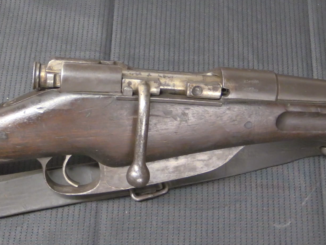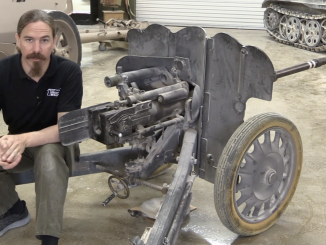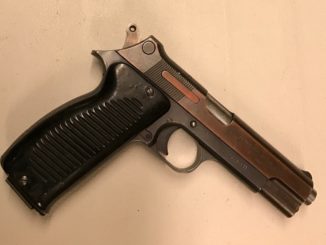Unlike most countries that adopted bullpup rifles, the French military never had a short-barreled version of their standard FAMAS. However, GIAT created several prototypes as part of their (ultimately unsuccessful) effort to market the FAMAS internationally. Today, we have two to look at, both with approximately 11.25 inch barrels. They are both based on the G2 pattern rifle, using AR-type magazines (specifically, FN FNC magazines, as GIAT and FN were under the same ownership at the time). The bolt carriers have been lightened to account for the reduced barrel length, and one has a vertical front grip while the other has a horizontal hand stop type grip. They also each have different types of sights, as this was clearly an area of experimentation…
Many thanks to the French Ministry of the Interior for providing access to film these prototypes!




I’ve always felt that chopping the barrel of a 5.56 x 45mm shorter than 16″ (40.6cm) turns a reasonable assault rifle or carbine into an indifferent submachine gun.
It robs the 5.56 of the muzzle velocity which is its raison d’etre to begin with. Without that velocity, it’s not an effective man killer.
In exchange you get increased blast and flash, which is a handicap in night combat, and increased muzzle sound signature from what’s already one of the loudest infantry rifle rounds ever made. All of which also does a decent job of giving away your position to the other guy.
Steyr had a short-barreled version of the AUG in 5.56mm- and found out that the only “shorty” their customers were willing to buy in quantity was the 9 x 19mm version. A 9 x 19mm version of this would be highly interesting, as well, and would probably have been easier to make due to the FAMAS having a delayed-blowback action as opposed to the AUG’s gas-piston system.
The more I see of “shorty” or sawn-off rifles firing 5.56 x 45mm or 5.45 x 39mm, the more I suspect that the users would probably be better off with the same or similar weapons in 9 x 19mm.
Not least because with the 9, they wouldn’t go in with an unrealistic expectation of their effective range. And they wouldn’t come out needing hearing aids.
cheers
eon
Practical view Eon. To me this chopped Famas does not make sense. I’d definitely would not want to shoot it in heat for fear of loosing fingers. They should have instead developed their own shorter small bore round – say something like 6×40.
It appears that people forgot about basic design principles when they chopped down the barrels. The product must match the intended usage parameters in both performance and ergonomic needs. Nobody snipes a melon from two miles away with a ballistic knife or hauls a pneumatic mortar into a hand-to-hand brawl. And yet people keep doing similar things like putting a scope on a Desert Eagle or trying to convert an anti-materiel rifle into a sub machine gun. I could be wrong.
Looks like an ideal pairing for .22 TCM: keep most of the powder generating useful velocity from that 11.25″ barrel, but subtract all the powder that contributes nothing but blast and flash – resulting in a 3/4″ shorter case, less recoil, cartridge weight, magazine bulk, etc.
“(…)sawn-off rifles firing(…)5.45 x 39mm, the more I suspect that the users would probably be better off with the same or similar weapons in 9 x 19mm.(…)”
Or, if higher penetration is required, then there is 9×39 cartridge: https://modernfirearms.net/en/cartridge/9×39-2/
All I can say is that the noise and the gas must have been epic for the shooter; it’s already bad enough with most bullpup configurations, but that short-arse barrel plus the FAMAS configuration putting it that close to your face…? Nuts.
I think that a lot of the reason you see such reduced interest in the bullpup configuration is people realizing just how much health damage you do to your troops having the damn muzzles so close to their primary breathing orifices. Unless you have them mask up, or issue snorkels, there’s no damn way to get clean air when you’re firing these things on a continual basis, as in combat. Intermittent peacetime shooting, where the rifles are carried more as costume props than as actual weapons–No problem. Constant shooting? Big ‘effing problem–One of the Brits I shot the L85 with made that point, exactly. It was his contention that one of the main reasons that the various British special forces went with the AR-15 family of weapons was because they could do a lot more shooting with them in training before Health and Safety shut them down. He told me that when he was training CQB with the L85, the guys monitoring the amount of heavy metal getting into the instructors blood freaked them out, and they’d had to make major changes to the POI and indoor ranges to reduce exposure for the demonstrators.
One has to wonder if we need gas masks at the firing range just to keep powdered lead out of our lungs. Either that or bullet cores need to be fully encased in copper just to keep the lead from flaking out!
That was the main reason for the Totally Metal Jacketed (TMJ) type bullet’s development. To reduce lead dust and etc. on indoor ranges.
The difference with standard Full Metal Jacket (FMJ) isn’t just that the FMJ generally has the lead core exposed at the base of the bullet, it’s the way the bullet is “built”.
FMJs have a jacket that’s drawn much like a cartridge case. The bullet core is inserted from the rear and the jacket is swaged down to lock it in.
TMJs have a core that has the jacket electrolytically plated over its entire surface. So not only are there no “seams”, technically the jacket is a coating rather than a separate piece.
Actually, with modern-day production techniques, TMJ bullets are a bit faster and cheaper to manufacture than “traditional” FMJ bullets. After all, electrolytic plating is used in a lot of industries. Even making plastic model kits. (Yes, that’s how they make the “chromed” parts in model cars.)
cheers
eon
The second sight with the v notch and post reminds me of the guttersnipe sight seen on some pistols.
That sight reminds me of the .22 rifle I learned to shoot on. Very accurate at .22 ranges.
The only way these horrible things could have been used would have been with a decent silencer on the barrel, which rather defeats the object.
I can only say that if you want a 5.56mm weapon, but the FAMAS is too long, then you had better have a good old think about what you are doing.
Here’s a suggestion: rethink the desired cartridge and system altogether!
That screams to be chambered in 300 blackout.
OK, it’s French, have them develop their own proprietary cartridge the 7.5x37mm French Commando. Bet it would duplicate 7.62x39mm out of that short barrel.
The screaming to be chambered in .300 Blackout will only ring in U.S. ears. Everyone else would use the 7.62×39, admittedly not in a FA MAS variant. In any case, the French units guarding embassies in remote places, use weapons firing 7.62×39. A smart decision in my view.
French are buying HK rifles and HK now offers 300 blackout variants HK237(G36), HK337(416) and HK437. Some small countries are starting to adopt the cartridge, especially in short AR variants. It would be interesting to see a level delayed blow back in the 300blk.
What is your source for the 7.5x37mm?
The only one I found refer it as British model.
http://www.users.globalnet.co.uk/~dheb/2300/Colonies/Tanstaafl/TBA.htm
The French GIAT have 7.62x39mm rifles.
The French Armée de Terre went and adopted the Hochler und Keck 416 with most having insanely short 11.5″ barrels, so it’d be the same length as the 19″ barrel of the FAMAS G1 that it first supplements, and eventually, maybe, someday will replace.
I appreciate the criticisms of these mini-bullpup-blasters-and-eardrums-and-support-hand-destroyers… Nonetheless, these French prototypes appear “ahead of their time” insofar as IWI appears to have brisk sales with the various min Tavor options, no?
Apologies, CZ BREN used by GIGN… can’t edit, I’m afraid!
Militaries are learning the wisdom of “suppress everything”. So shorter barrels make sense.
Always wondered why the FAMAS wasn’t more popular…
Can’t be because it’s a bullpup, the Steyr AUG seemed to do just fine.
Was it just a matter of bad timing or what?
How about the delayed blowback system that wasn’t compatible with brass-cased 5.56 NATO ammunition? I’d hate to imagine forcing the FAMAS F1 to eat American ball-powder cartridges…
The Brits chopped their bullpup for backup guns issued to vehicle crews – seen a pic of one slung in a Brit helicopter. 5.56x45mm does seem to have reasonable effectiveness from shorter bbls – particularly w/ non-Geneva compliant bullet designs. 5.56x45mm pistols are quite popular now in the US.
Yes, and if you use “exploding” bullets on someone in wartime and get caught mutilating your intended victim into giblets, expect to get hauled off the battlefield naked and then chained to a rock on a charge of “administering a cruel and unusual death.” A bit of exaggerated nonsense, but I have heard of dumber court-martial results… like sentencing a man to hang for insulting the general’s wife in front of the general!
Popular doesn’t always equal smart. The Corvair was popular. So were the Ford Pinto and the Chevy Vega.
5.56mm “pistols” are mostly based on the AR-15 action. Which is fairly easy to make work (more or less) minus most of its barrel, gas tube, and buffer tube, as was proven with the XM177 “SMG” and the M231 Firing Port Weapon.
Those two also proved that “pistolizing” the M16, or any 5.56mm, is an outstandingly bad idea.
The fact that most M231s ended up being “rebuilt” into the first generation M4s was mostly Army Ordnance’s way of getting rid of the FPW without admitting that they were doing it.
The M4 with its 14.5in (36.83 cm) barrel isn’t quite as bad an idea as it could have been. Although I’ve yet to see one achieve its listed MV of 2,970 F/S (905 m/s) over an honest chronograph.
cheers
eon
XM-177 grew into the M4 b/c BATFE declared the baffled flash hider a suppressor, and the 1:12″ twist bbl was causing baffle strikes. 14.5″ bbl w/ 1:7″ twist doesn’t have those issues. The M231 was useless not b/c of its design but b/c of its specifications. If they’d slowed the cyclic rate down to standard M-16 and thrown a collapsible wire stock & a red dot on it it might be the M4 of today. Would still be obsolete from the additional armor covering over the firing ports of the Bradley.
AR pistols are quite popular among US civilians b/c we can get decent hollowpoint ammo for them, and it’s quite a bit of power in a compact truck gun. .300 Blackout is becoming a popular caliber for em as well.
With an 11-inch barrel, the bullet velocity of a French cartridge at close range is still quite sufficient. Although, this is already close to the limit.
Muzzle signature, yeah…
There’s nothing you can do. The desire to use standard ammunition comes at a price. At least they did everything they could to reduce the impact on the shooter.
The use of an enlarged hand guard as a front grip solves handling and safety issues.
Much more interesting, how much did they reduce the weight of the bolt carrier? And what was the rate of fire they got in auto mode?
It’s a shame that Ian (apparently) won’t be allowed to shoot this…
How much is the weight of the bolt carrier and bolt on a normal Famas rifle variant?
Do you know… If you used flechettes “Which is a French word” as is merde, but without rifling; couldn’t you have extendable barrels? Take this, but you have an oval shaped bit that looks like a silencer thing… Right, but instead you click it on and rotate it; so the bottom becomes top… Spring out extra barrel like a flick knife, press a button and it springs out from the barrel “bottom bit being a sleeve here” Niti gas seals… Or something.
In theory you’d still gain more powder burn.
Barrel bit of oval sits above the actual barrel… Or to simplfy, you just screw on an extra barrel like you would a suppressor.
To be honest, I am assuming they don’t do this already due to the rifling. Or the seal maybe… ?
No gas system has it, the oval “thing” could sit under the current carry handle, press a button and gain 12″ of barrel.
Wee darts are smoothbore anyway I think.
Give it an Ar style rear cocking handle, via cheek piece lip or something; ways.